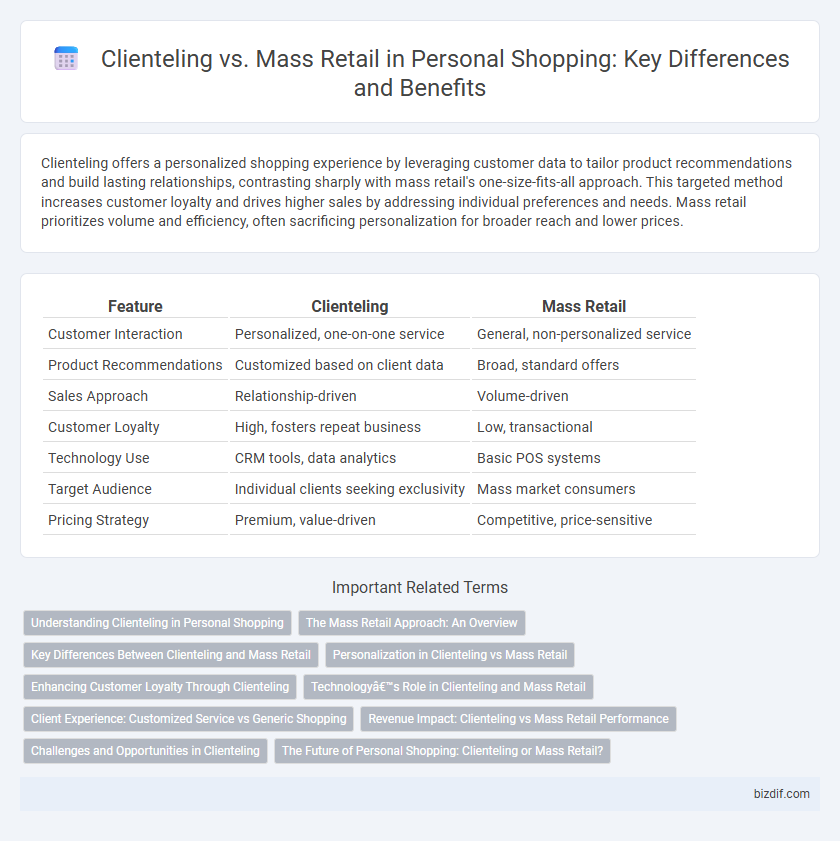Clienteling offers a personalized shopping experience by leveraging customer data to tailor product recommendations and build lasting relationships, contrasting sharply with mass retail's one-size-fits-all approach. This targeted method increases customer loyalty and drives higher sales by addressing individual preferences and needs. Mass retail prioritizes volume and efficiency, often sacrificing personalization for broader reach and lower prices.
Table of Comparison
| Feature | Clienteling | Mass Retail |
|---|---|---|
| Customer Interaction | Personalized, one-on-one service | General, non-personalized service |
| Product Recommendations | Customized based on client data | Broad, standard offers |
| Sales Approach | Relationship-driven | Volume-driven |
| Customer Loyalty | High, fosters repeat business | Low, transactional |
| Technology Use | CRM tools, data analytics | Basic POS systems |
| Target Audience | Individual clients seeking exclusivity | Mass market consumers |
| Pricing Strategy | Premium, value-driven | Competitive, price-sensitive |
Understanding Clienteling in Personal Shopping
Clienteling in personal shopping leverages personalized customer data to create tailored shopping experiences, enhancing customer loyalty and satisfaction compared to mass retail approaches. By utilizing client profiles, purchase history, and preferences, personal shoppers can offer curated product recommendations and exclusive services that mass retail cannot match. This targeted engagement drives higher conversion rates and fosters long-term customer relationships in the competitive retail landscape.
The Mass Retail Approach: An Overview
The mass retail approach prioritizes volume sales through broad customer targeting, leveraging standardized product offerings and promotions to attract a wide audience. This method relies heavily on extensive inventory management, competitive pricing strategies, and large-scale advertising campaigns to drive traffic and increase turnover. Unlike personalized clienteling, mass retail emphasizes efficiency and reach over individualized customer experiences.
Key Differences Between Clienteling and Mass Retail
Clienteling emphasizes personalized interactions by leveraging detailed customer data to tailor recommendations and foster loyalty, whereas mass retail relies on standardized marketing and broad consumer targeting. Clienteling involves one-on-one engagement, often through sales associates using CRM systems to track preferences and purchase history, while mass retail typically employs universal promotions and large-scale inventory management. This personalized approach in clienteling enhances customer experience and retention, contrasting with the efficiency and scalability priorities of mass retail.
Personalization in Clienteling vs Mass Retail
Clienteling delivers personalized shopping experiences by leveraging customer data and purchase history to tailor recommendations and offers, enhancing customer loyalty and satisfaction. Mass retail typically relies on broad marketing strategies and generalized promotions that lack individual customization, often leading to lower engagement. Personalization in clienteling drives higher conversion rates and repeat visits by addressing unique customer preferences, unlike mass retail's one-size-fits-all approach.
Enhancing Customer Loyalty Through Clienteling
Clienteling leverages personalized interactions and detailed customer insights to create tailored shopping experiences that significantly boost customer loyalty compared to mass retail approaches. By utilizing data-driven recommendations and individual preferences, clienteling fosters stronger emotional connections and repeat purchases. Retailers employing clienteling methods report higher customer retention rates and increased lifetime value, emphasizing its effectiveness in enhancing loyalty.
Technology’s Role in Clienteling and Mass Retail
Technology in clienteling leverages CRM systems, AI-driven personalization, and mobile apps to deliver tailored shopping experiences, increasing customer loyalty and sales conversion. In mass retail, technology relies on big data analytics, inventory management, and automated marketing campaigns to optimize operations and target broad consumer segments efficiently. The distinction lies in clienteling's focus on individualized interaction through real-time customer insights, contrasted with mass retail's emphasis on scale and process automation.
Client Experience: Customized Service vs Generic Shopping
Clienteling enhances the client experience by delivering personalized service tailored to individual preferences, purchase history, and style, creating a unique and engaging shopping journey. In contrast, mass retail offers generic shopping experiences that lack customization, often leading to lower customer satisfaction and limited brand loyalty. Personalized clienteling leverages data-driven insights and direct communication, fostering stronger relationships and higher repeat purchase rates.
Revenue Impact: Clienteling vs Mass Retail Performance
Clienteling drives higher revenue impact by enabling personalized recommendations and fostering customer loyalty, resulting in increased average order values and repeat purchases. Mass retail relies on broad marketing strategies that generate high traffic but often yield lower conversion rates and reduced customer lifetime value. Data shows clienteling can boost revenue per client by up to 30%, highlighting its superiority over mass retail approaches in maximizing sales performance.
Challenges and Opportunities in Clienteling
Clienteling faces challenges such as maintaining personalized customer data and ensuring consistent, high-quality interactions across touchpoints. Opportunities in clienteling include leveraging advanced CRM systems and AI-driven insights to tailor product recommendations and enhance customer loyalty. This personalized approach contrasts mass retail's broad reach, enabling deeper engagement and higher customer lifetime value.
The Future of Personal Shopping: Clienteling or Mass Retail?
Clienteling leverages personalized data and customer insights to create tailored shopping experiences that enhance loyalty and increase lifetime value, whereas mass retail relies on broad, one-size-fits-all approaches with less individual engagement. Advances in AI and machine learning enable clienteling platforms to predict customer preferences and deliver highly relevant recommendations, driving higher conversion rates compared to traditional mass retail models. The future of personal shopping is increasingly shaped by clienteling's ability to foster meaningful connections and deliver customized service at scale, challenging the limitations of mass retail strategies.
Clienteling vs Mass retail Infographic

 bizdif.com
bizdif.com